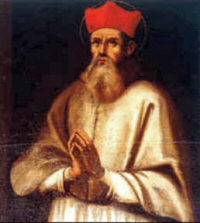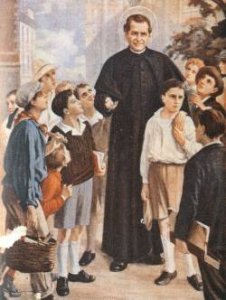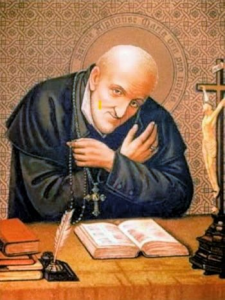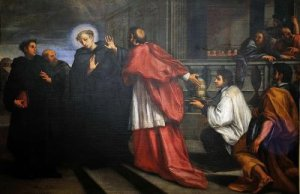 Saint Peter Damian
Saint Peter Damian
Cardinal Bishop (988-1072)
Feast – February 23
“You are the salt of the earth. But if salt loses its taste, with what can it be seasoned? It is no longer good for anything but to be thrown out and trampled underfoot.” (Matt 5:13)
The words of a holy priest, supported with a good example, has the power to change hearts. The words of a hypocrite have no force, this is why earthly powers work hard to influence and corrupt the Church. It is a constant struggle.
To combat evil influences causing corruption from within, the Church has gradually made a series of adjustments. One of the largest were the eleventh century (1050–80) Gregorian Reforms, which are also known as the Hildebrand Reforms. To pave the way for these reforms, God sent St. Peter Damian.
Born around 1007 in Ravenna, the Emilia-Romagna region of Northern Italy, St. Peter was the youngest of a large noble family. He lost both his parents at an early age. Left in the hands of his eldest brother, he was mistreated and used as a swineherd. When his other brother, Damian, who was archpriest (pastor of the principal parish among several local parishes) at Ravenna, learned about this he took St. Peter away to be educated. Having found a father in this brother he adopted from him the surname of Damian. He made rapid progress in his studies, first at Ravenna, then at Faenza, and finally at the University of Parma. At the age of 25, he became highly regarded for his knowledge and piety among the professor at Parma. He had already begun to inure himself to fasting, watching and prayer, and wore a hairshirt under his clothes to arm himself against the allurements of pleasure and the wiles of the devil. Not only did he give away much in alms, but he was seldom without some poor persons at his table and took pleasure in serving them. Tired of the distractions at a busy university, he decided to retire from the world and give himself completely to prayer. While meditating on his resolution he encountered two hermits. Charmed with their spirituality and detachment, he joined them on a forty-day retreat in a small cell. After the experience St. Peter Damian left his friends secretly and made his way to the Benedictines of the reform of Saint Romuald hermitage of Fonte Avellana (The Venerable Hermitage of the Holy Cross) in the Marche region of Italy.
The monks lived two to a hermitage and occupied themselves chiefly in prayer and reading. Both as a novice and as a monk, St. Peter’s fervor was remarkable but led him to such extremes of self-mortification in penance that he developed severe insomnia, which was cured with difficulty and taught him to use more moderation. Acting upon this experience, he now devoted considerable time to Sacred studies, and became so proficient in the Holy Scriptures that was appointed to lecture to his fellow monks and often requested to talk in the neighboring monasteries. About 1042 he wrote a biography on the life of St. Romuald.
By the unanimous consent of the hermits, he was ordered to take upon himself the government of the Community in the event of the superior’s death. St. Peter’s extreme reluctance obliged the abbot to make it a matter of obedience. Accordingly, after the abbot’s death about the year 1043, he assumed the direction of that holy family, and remained in charge until his death in February 1072. His chief care was to foster in his disciples the spirit of solitude, charity, and humility. A zealot for monastic and clerical improvements, leading by his own example he introduced a more-severe discipline, including the regular practice of flagellation (used in moderation) into the house. This custom quickly became a model for other foundations, among them the great abbey of Monte Cassino. The daily siesta, to make up for the fatigue of the night office was added to monks’ daily routine.
During his tenure, a cloister was built, silver chalices and a silver processional cross were purchased, and many books were added to the library. He also founded hermitages at San Severino, Gamogna, Acerreta, Murciana, San Salvatore, Sitria and Ocri, in which he placed Priors under his own general direction.
Although living in the seclusion of the cloister, St. Peter was aware of the problems and challenges the Church was facing, so he wrote over 170 letters addressing corruption (simony), lack of discipline, doctrinal ignorance of the clergy as well as intrusion of local civil authorities into Church matters. In letters he preferred examples and stories rather than pure theory, which make them persuasive. One of his first letters was written in 1045 to the new pope, Gregory VI, in which he hailed the change with joy and urged him to deal with the scandals of the church in Italy, singling out the wicked bishops of Pesaro, Città di Castello and Fano. About 1051, he wrote Liber Gomorrhianus, a book addressed to Pope Leo IX, containing a scathing indictment of the practice of sodomy, which was threatening the integrity of the clergy.
The Holy See began to view St. Peter Damian as a peacemaker. He would be called to settle disputes between two abbeys or clerics, as well as disagreements with government officials. Soon, the most delicate and difficult missions were placed in his hands. Seven Popes in succession made him their constant adviser.
In 1057, Cardinal Frederick of Lorraine, abbot of Monte Cassino, was elected Pope as Stephen IX. He determined to make St Peter a cardinal. St Peter resisted the offer but eventually was forced to accept, being consecrated Cardinal Bishop of Ostia on the 30th of November, 1057. This came with the charge of administrating the Diocese of Gubbio. He would later solicity Nicholas II to grant him leave to resign his bishopric and return to solitude, but the Pope had always refused.
The new Cardinal wished to restore primitive discipline among religious and priests, warning against needless travel, violations of poverty, and living too comfortably. He encouraged his priests to observe celibacy, urged them to live together and maintain scheduled prayer and religious observance. He also wrote a letter to his brother-cardinals, exhorting them to shine by their example before all. When four months later Pope Stephen died in Florence, St. Peter Damian, as a vigorous opponent to the antipope Benedict X, had to temporarily retire to Fonte Avellana. After Benedict’s surrendering the papacy in the autumn of 1059, Pope Nicholas II sent St Peter Damian with Bishop Anselm of Lucca as legates to Milan where benefices were openly bought and sold, and clergy being publicly married became normal. The party of the irregular clerics denied Rome’s authority over Milan. St. Peter boldly confronted them in the cathedral and proved to them the authority of the Holy See with such effect that all parties submitted to his decision.
In 1061 He withstood Henry IV of Germany and labored in defense of the newly elected Pope Alexander II against the antipope Cadalous. His long argument by was read at council in Augsburg and greatly contributed to the decision in favor of Alexander II.
In 1063 he was appointed legate to settle the dispute between the Abbey of Cluny and the Bishop of Mâcon. He proceeded to France, summoned a council at Chalon-sur-Saône, resolved the issues and returned in the autumn to Fonte Avellana. In 1067, he was sent to Florence to settle the dispute between the bishop and the monks of Vallombrosa. Having served the papacy as legate to France and to Florence, he was finally was allowed to resign his bishopric in 1067, but Pope Alexander II reserved the power to employ him in Church matters of importance, as he might hereafter have need of his help.
In 1069 he proceeded as papal legate to Germany and persuaded emperor Henry IV to give up his intention of divorcing his wife, Bertha. Then in early in 1072 he was sent to adjust the affairs of the Church at Ravenna. After completing these tasks, upon his return he was seized with fever and lay ill for a week in a monastery outside Faenza. On the night of the feast of the Chair of St. Peter on February 22, 1072, with the monks gathered around him saying the Divine Office, he died.
St. Peter is one of those stern figures who seem specially raised up, like St. John Baptist, to remind men in a lax age of the error of their ways and to bring them back to the narrow path of virtue.
He often condemned philosophy. He argued that monks should not have to study philosophy, because Jesus did not choose philosophers (theoreticians) as disciples, and so philosophy concerned with the validity of argument, rather than the full nature of reality is unnecessary and may become an obstacle for salvation. He was a man of great vehemence in all he said and did; it has been said of him that “his genius was to exhort and impel to the heroic, to praise striking achievements and to record edifying examples…an extraordinary force burns in all that he wrote.”
In 1828, Pope Leo XII declared St Peter Damian as a Doctor of the Church.
Pope Benedict XVI described him as “one of the most significant figures of the 11th century, … a lover of solitude and at the same time a fearless man of the Church, committed personally to the task of reform.”
References and Excerpts:
[1] F. Media, “Saint Peter Damian,” Franciscan Media, Feb. 21, 2020. https://www.franciscanmedia.org/saint-of-the-day/saint-peter-damian/ (accessed Feb. 10, 2023).
[2] C. Online, “St. Peter Damian – Saints & Angels,” Catholic Online. https://www.catholic.org/saints/saint.php?saint_id=780 (accessed Feb. 10, 2023).
[3] “Saint Peter Damian, Cardinal Bishop.” https://sanctoral.com/en/saints/saint_peter_damian.html (accessed Feb. 10, 2023).
[4] “Optional Memorial of St. Peter Damian, bishop and doctor – February 21, 2015 – Liturgical Calendar.” https://www.catholicculture.org/culture/liturgicalyear/calendar/day.cfm?date=2015-02-21 (accessed Feb. 10, 2023).
[5] “CATHOLIC ENCYCLOPEDIA: St. Peter Damian.” https://www.newadvent.org/cathen/11764a.htm (accessed Feb. 10, 2023).
[6] “Peter Damian,” Wikipedia. Nov. 26, 2022. Accessed: Feb. 10, 2023. [Online]. Available: https://en.wikipedia.org/w/index.php?title=Peter_Damian&oldid=1123860394
 Saint John Bosco
Saint John Bosco Saint Dominic of Silos
Saint Dominic of Silos Saint John Berchmans
Saint John Berchmans Saint Alphonsus Rodriguez
Saint Alphonsus Rodriguez Saint Vincent Strambi
Saint Vincent Strambi Saint Philip Benizi
Saint Philip Benizi Saint Eugenius
Saint Eugenius Saint Prosper of Aquitaine
Saint Prosper of Aquitaine Saint Gregory Nazianzen
Saint Gregory Nazianzen